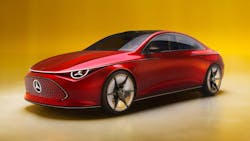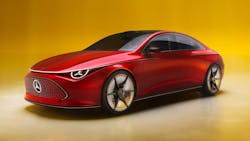Mercedes-Benz Displays Its EV Future at IAA Mobility 2023
What you'll learn:
- What is the Mercedes-Benz Modular Architecture (MMA)?
- Details of the "MB.OS" operating system and "MB. EDU" driving unit.
- Use of carbon-dioxide-reduced aluminum.
- Mercedes-Benz's "Ambition 2039" vision of the future.
Range and efficiency will define the electric-vehicle era. Extending range will make electric cars suitable for every journey and ultimately speed adoption. And higher efficiency will result in battery size and weight reduction, again allowing us to go further on a single charge.
At IAA Mobility 2023 in Munich, Mercedes-Benz Group AG CEO Ola Källenius pulled the curtain back on the future of the company’s sustainable luxury automobiles. Based on the new Mercedes-Benz Modular Architecture (MMA), M-B’s Concept CLA Class—a "close-to-production" take on the next generation of entry-level Mercedes—made its mark through long-range efficiency, sustainable materials, and an entirely new operating system.
Let’s look at these innovations one at a time:
466-Mile Range (WLTP cycle)
The Concept CLA Class is the forerunner of the first model family designed on the all-new MMA. Using an in-house-developed electric drive unit, the Concept CLA Class has an anticipated range of more than 750 km (466 miles, based on the more optimistic European WLTP cycle) on a single charge. This represents an energy consumption of around 12 kWh/100 km (5.2 miles/kWh).
M-B points out that this range could easily take you from Munich to Hamburg (380 miles) on a single charge. In a world where big EVs are more popular because they can simply mask the weight of a larger battery, the CLA offers this range in a much smaller body.
MB.OS
The vision for the Mercedes-Benz of tomorrow redefines the car as an entertainment and gaming center, a productivity zone, a private oasis, even part of a server farm and the energy grid. To achieve this vision by leveraging the full potential of current and future software-driven innovation, Mercedes-Benz developed its own operating system called MB.OS. This proprietary chip-to-cloud architecture represents a completely new approach for the company and will be a defining aspect of all its future vehicles.
The aim of MB.OS is to decouple hardware and software and make software development faster and more adaptable. As an example, consider the complex multifaceted architecture of the water-cooled chip from collaboration partner NVIDIA. This partnership will help equip every vehicle built on the MMA platform with a “supercomputer.”
The MMA platform will be the first to run fully on MB.OS. The Concept CLA Class offers a taste of what this will mean for customers.
Mercedes-Benz Electric Drive Unit (MB.EDU)
The new MB.EDU, comprising motor, transmission, and power electronics, was developed entirely in-house. Based on a modular concept, it’s the first in a family of drive units that will be engineered to meet a wide range of performance demands across a number of model lines. The 175-kW, permanently excited synchronous machine is paired with a two-speed transmission. The power electronics incorporate control of motor and transmission in a single processor and feature a silicon-carbide inverter for efficient power usage.
A high degree of functional integration throughout the MB.EDU results in a compact overall package weighing less than 243 lbs. Its energy efficiency of up to 93% from battery to wheel in long-distance driving is due to minimization of losses throughout the system and, according to M-B, places it at the forefront of the sector.
High-Voltage Battery
The new architecture is built around batteries attached by adhesive rather than screws, both reducing weight and adding a rigidity that helps in a crash. The battery system under development for the MMA platform is based on a highly modular architecture.
Customers can choose from two different cell chemistries—one using silicone oxide and the other utilizing lithium iron. It’s paired with an 800-V configuration to allow for charging on a high-speed 250-kW DC charger. If such a charger is working at full capacity, that means the car can reach 248 miles of range in 15 minutes.
An Energy-Storage Device
The Concept CLA Class also offers a glimpse into the future of networking between electric vehicles and the energy grid. Software- and hardware-based bidirectional charging shows how this technology opens up new potential for customers and energy providers alike.
When connected to a compatible bidirectional DC charging station, the vehicle becomes an energy-storage device that could, for instance, store solar power for later use. Most importantly, it can also serve as an electricity supply, either vehicle-to-home (V2H) or vehicle-to-grid (V2G). M-B cautions that the use of bidirectional charging may be subject to market-specific conditions with respect to legislation and the requirements of energy suppliers.
Sustainable Materials
The MMA platform is central to the effort made by Mercedes-Benz regarding the use of CO2-reduced aluminum. In Europe, at least one third of the aluminum in the upcoming electric model generation will be produced with renewable energy. Consequently, it will lower the CO2 footprint of this aluminum by a minimum of 40% compared to aluminum used in Europe, equating to a reduction of around 300 kg of CO2 emissions per vehicle. Applications cover a wide range of components from the wheels to the battery housing.
On the path toward a fully responsible aluminum supply chain, the company will significantly increase the share in future models of aluminum certified according to the standards of the Aluminum Stewardship Initiative (ASI). Currently, the aluminum sheet for in-house press parts is sourced from ASI-certified suppliers.
SAE Level 3 Ready
Future SAE Level 2 applications must be prepared for the use of LiDAR-supplemental sensing technology to meet the high operational complexities and safety demands of urban traffic. It will be possible to enhance these via over-the-air updates, even after vehicle purchase. This also means that Mercedes-Benz will be able to continually improve existing systems and make them available to customers (taking account of local legislative frameworks).
The MB.OS software and its computing power is generally said to be ready for an SAE Level 3 system upgrade for vehicles equipped with a comprehensive sensor set, including a LiDAR sensor and redundancies for vital vehicle systems.
Ambition 2039
By now, we hear you saying to yourself that concept cars always display features that probably will not make it to production. And while this is true, M-B has already outlined its vision of the future in what they call “Ambition 2039.” This is the first family of Mercedes-Benz vehicles designed from scratch to put Ambition 2039 on the road, reducing value-chain CO2 by more than 40% compared to the previous architectures.
Ambition 2039 is a core element of the company’s sustainable business strategy with which it set its course in 2019 regarding climate protection and air-pollution control. The goal is to make M-B’s entire fleet of new vehicles net carbon-neutral along the entire value chain and over the vehicles' entire lifecycle by 2039—from technical development to the extraction of raw materials, to production, service life, and recycling.
By 2030, M-B aims to at least halve CO₂ emissions per passenger car over its lifecycle compared to 2020 levels. To achieve this goal, the key levers include electrifying its vehicle fleet, use of renewable energy in production, improving battery technology, extensive use of recycled materials, and charging vehicles with green energy.


